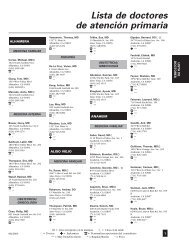CALIFORNIA - Pacificare Health Systems
CALIFORNIA - Pacificare Health Systems
CALIFORNIA - Pacificare Health Systems
You also want an ePaper? Increase the reach of your titles
YUMPU automatically turns print PDFs into web optimized ePapers that Google loves.
PART A<br />
86<br />
Payment Responsibility<br />
for medical and Hospital Services at the lowest cost by<br />
avoiding excessive or duplicate payments.<br />
The objective of COB is to ensure that all group <strong>Health</strong><br />
Plans that provide coverage to an individual will pay<br />
no more than 100 percent of the allowable expense for<br />
services that are received. This payment will not exceed<br />
total expenses incurred or the reasonable cash value<br />
of those services and supplies when the group <strong>Health</strong><br />
Plan provides benefits in the form of services rather<br />
than cash payments.<br />
PacifiCare’s COB activities will not interfere with<br />
your medical care.<br />
The order of benefit determination rules below<br />
determine which <strong>Health</strong> Plan will pay as the Primary<br />
Plan. The Primary Plan that pays first pays without<br />
regard to the possibility that another plan may cover<br />
some expenses. A Secondary Plan pays after the<br />
Primary Plan and may reduce the benefits it pays so<br />
that payment from all group plans do not exceed 100<br />
percent of the total allowable expense. “Allowable<br />
Expense” is defined below.<br />
Definitions<br />
The following definitions only apply to coverage<br />
provided under this explanation of Coordination of<br />
Benefits.<br />
A. Plan is any of the following that provides<br />
benefits or services for medical or dental care or<br />
treatment.<br />
1. Plan includes: group insurance, closed<br />
panel (HMO, POS, PPO or EPO) coverage<br />
or other forms of group or group-type<br />
coverage (whether insured or uninsured);<br />
Hospital indemnity benefits in excess of<br />
$200.00 per day; medical care components<br />
of group long-term care contracts, such as<br />
Skilled Nursing Care; or other governmental<br />
benefits, as permitted by law (Medicare is<br />
not included as a “Plan” as defined here –<br />
however, PacifiCare does coordinate benefits<br />
with Medicare.) Please refer to Section 7.<br />
“Important Rules for Medicare and Medicare-<br />
Eligible Members.”<br />
2. Plan does not include: non-group coverage<br />
of any type, including, but not limited to,<br />
individual or family insurance; amounts of<br />
Hospital indemnity insurance of $200.00 or<br />
less per day; school accident-type coverage;<br />
benefits for nonmedical components of<br />
group long-term care policies; Medicare<br />
supplement policies, a state-plan under<br />
Medicaid; and coverage under other<br />
governmental plans, unless permitted by<br />
law.<br />
Each contract for coverage under (1) or<br />
above is a separate Plan. However, if the<br />
same carrier provides coverage to members<br />
of a group under more than one group<br />
contract, each of which provide for different<br />
types of coverage (for example, one<br />
covering dental services and one covering<br />
medical services), the separate contracts are<br />
considered parts of the same plan, and there<br />
is no COB among those separate contracts.<br />
However, if a Plan has two parts and COB<br />
rules apply only to one of the two, each of<br />
the parts is treated as a separate Plan.<br />
B. Primary Plan or Secondary Plan – The order of<br />
benefit determination rules determine whether<br />
this Plan is a “Primary Plan” or “Secondary Plan,”<br />
when compared to another Plan covering the<br />
person. When this Plan is primary, its benefits are<br />
determined before those of any other Plan and<br />
without considering any other Plan’s benefits.<br />
When this Plan is secondary, its benefits are<br />
determined after those of another Plan and may<br />
be reduced because of the Primary Plan’s benefits.<br />
C. Allowable Expense means a health care<br />
service or expense, including deductibles and<br />
Copayments, that is covered at least in part by<br />
any of the Plans covering the person. When a<br />
plan provides benefits in the form of services,<br />
(for example, an HMO) the reasonable cash value<br />
of each service will be considered an Allowable<br />
Expense and a benefit paid. An expense or service<br />
that is not covered by any of the plans is not an<br />
Allowable Expense. The following are examples<br />
of expenses or services that are not Allowable<br />
Expenses:<br />
1. If a Covered Person is confined in a private<br />
Hospital room, the difference between the<br />
cost of a semi-private room in the Hospital<br />
and the private room (unless the patient’s<br />
stay in a private Hospital room is Medically<br />
Necessary) is not an Allowable Expense.








